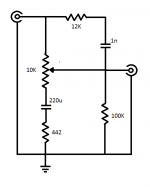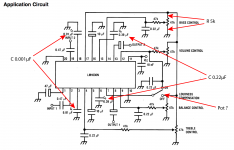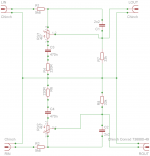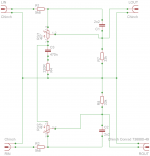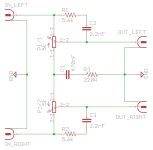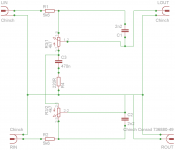The caps look OK, typical polyester film types. The use of the loudness function (pin 7 of the chip) is detailed in the data sheets. You will have to see how your board is configured to know if its used or whether its left non-functional.
I am looking into schematics and I wonder what would I get by making these modifications noted on pic...
Also, does it make sense to replace loudness switch with potentiometer in this case...?
My aim is to get nice and fat bass and bit of treble response, but in the way that I can level it with a potentiometer, if it is possible with this solution..
Thanks
Attachments
Interesting question. It looks as though the loudness could be made variable with a pot because all it does now is use the same DC control voltage as the volume input. So I would say probably yes, but it would be a non recognised loudness curve vs level i.e. you could apply a loudness contour to high output levels when you normally wouldn't do so.
Haven't got the data sheet in front of me but from what I remember altering those caps will change the turnover frequencies. Anything like that is trial and error to get the effect you desire.
Haven't got the data sheet in front of me but from what I remember altering those caps will change the turnover frequencies. Anything like that is trial and error to get the effect you desire.
Interesting question. It looks as though the loudness could be made variable with a pot because all it does now is use the same DC control voltage as the volume input. So I would say probably yes, but it would be a non recognised loudness curve vs level i.e. you could apply a loudness contour to high output levels when you normally wouldn't do so.
Haven't got the data sheet in front of me but from what I remember altering those caps will change the turnover frequencies. Anything like that is trial and error to get the effect you desire.
OK, great,
as soon as I get it I'll try with 50k lin. pot in the place of the loudness switch...
BTW, when I insert bypass switch before tone board, do I need to watch out for something special, like feedback signal from amp on the output of tone board?
Thanks
Not quite sure what you mean about the bypass thing. Normally you would apply the signal to the tone stage permanently and then just select either the tone output or the feed applied to the input to take forward to the next stage. In other words the signal has either been through the stage or not.
Not quite sure what you mean about the bypass thing. Normally you would apply the signal to the tone stage permanently and then just select either the tone output or the feed applied to the input to take forward to the next stage. In other words the signal has either been through the stage or not.
I plan to do exactly that.
I'm just wondering will there be anything wrong, signal wise, leaving tone board on?!
Can't see any problem. In fact the tone board should be powered up because left if unpowered then the input impedance could be low and very variable causing distortion due to non linear loading of the source stage feeding it.
In other words it presents as a high impedance when powered and so has no effect on the stage feeding it. When off it could be anything but.
In other words it presents as a high impedance when powered and so has no effect on the stage feeding it. When off it could be anything but.
OK, I finally got my hands on that tone board with LM1036 chip.
I connected it between my Audiophonics ES9023 DAC and Little Bear P-3 6N3 based preamp, after that signal goes to Sure TPA3116 amp. Tone board is driven by 12VDC switching PSU.
I get some noise and hiss out of it, especially when I turn up the volume on the board.
There is also "wobbling" effect on the speakers woofers when I turn volume up down, as if there is excess DC voltage going to the speakers.
Now, there are two things that I am aware of that could cause these problems:
1. this tone board and LM1036 are made for lower Vrms than I get out of ES9023 based DAC
2. there are two plain electrolytic 4.7µF condensers on the output signal path. However, ones on the input are film based.
How exactly could I lower my signal to below 1Vrms coming from DAC (I believe it is around 2Vrms, not sure though). A fellow told me to make an "Pi" attenuator, but I need to know what resistors to get for it?
I already ordered WIMA MKS 4.7µF caps for output signal coupling.
Is there anything else that could be causing my problems?
Thanks in advance
I connected it between my Audiophonics ES9023 DAC and Little Bear P-3 6N3 based preamp, after that signal goes to Sure TPA3116 amp. Tone board is driven by 12VDC switching PSU.
I get some noise and hiss out of it, especially when I turn up the volume on the board.
There is also "wobbling" effect on the speakers woofers when I turn volume up down, as if there is excess DC voltage going to the speakers.
Now, there are two things that I am aware of that could cause these problems:
1. this tone board and LM1036 are made for lower Vrms than I get out of ES9023 based DAC
2. there are two plain electrolytic 4.7µF condensers on the output signal path. However, ones on the input are film based.
How exactly could I lower my signal to below 1Vrms coming from DAC (I believe it is around 2Vrms, not sure though). A fellow told me to make an "Pi" attenuator, but I need to know what resistors to get for it?
I already ordered WIMA MKS 4.7µF caps for output signal coupling.
Is there anything else that could be causing my problems?
Thanks in advance
Last edited:
So, is there a loudness control without a variable pot? I just want your basic switch or button to activate the loudness, no pot. I can experiment with values, but I'm not sure how it'd change the schematics above. (My ability to read a schematic is rudimentary at best).
Also, two questions:
1) What's the gain loss in dB?
2) Does this boost only bass? Or is treble boosted as well?
Charles.
Also, two questions:
1) What's the gain loss in dB?
2) Does this boost only bass? Or is treble boosted as well?
Charles.
So, is there a loudness control without a variable pot? I just want your basic switch or button to activate the loudness, no pot. I can experiment with values, but I'm not sure how it'd change the schematics above. (My ability to read a schematic is rudimentary at best).
Also, two questions:
1) What's the gain loss in dB?
2) Does this boost only bass? Or is treble boosted as well?
Charles.
If You are talking about schematic I posted, it is of the working tone board i got from eBay, there is a switch for loudness.
There are several versions of it on eBay, look for one that has switch already mounted, mine has jumper. I plan to insert it into my system.
This is a passive loudness circuit that can be put on the end of a pre amp...
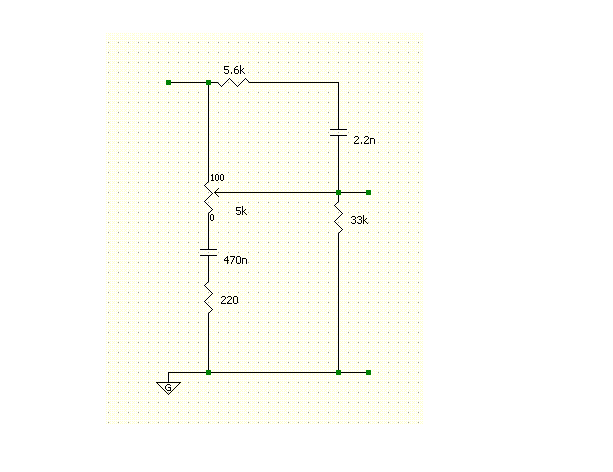
The effect as you turn the pot over full rotation is...
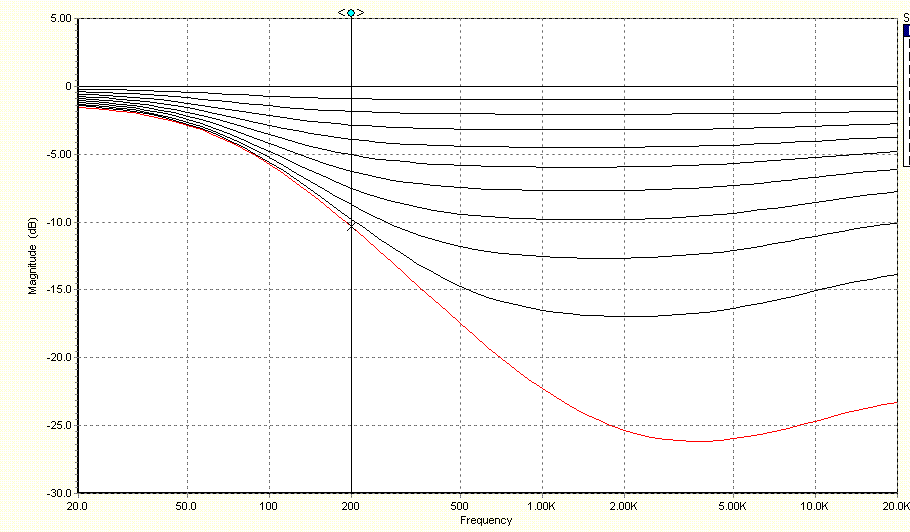
The 33k resistor is just to simulate a typical load and is not needed it will drive a following circuit over about a 20-100k range withought very much change in the frequency response.
The component values can be scaled to for instance use the 10k motorised pot widely available here in Oz. In this case just double all resistors and halve capacitors.
rcw
I built this circuit last night on a proto board. I doubled the resistors and halved the caps as per your instructions because I am using a 10k stereo ALPS.
The circuit works, but the effect is very subtle. Based on my ears alone, I suspect I am only pushing the curve down about 3-4 dB with the POT at max setting.
It sounds excellent, but I would like to have more variability in this variable control. Right now it is only useful at maximum setting, and just barely so.
I assume it is a matter of changing some component values but I have no idea where to begin. One thing I checked is the real resistance of the ALPS, which is much closer to 9k than 10k. Does this mean the resistors elsewhere in the circuit should have been scaled accordingly?
Thanks to anyone who would be kind enough to suggest which component values to change to simply achieve a greater range of effect, without changing the resulting F-M curve too much.
So, it was a rookie electronics mistake. 
Since the schematic is mono and I wanted to build a stereo version, I doubled the circuit and, as such, doubled all the parts. Not just the "signal" parts, but the "ground" parts as well. What I realized, however, is that the ground connections are all common to each other so doubling up on the "ground" parts (cap and resistor) was a mistake.
I plugged in the soldering iron and a few minutes later I had removed the redundant (parallel) cap and resistor from the ground path, so now both ground connections from the POT are grounded through the same cap and resistor.
The variable loudness control is now much more effective. At maximum setting it is now almost too "laid back" for my taste.
I am very excited that this was such a success! It is the first time I have ever built a circuit from scratch.
Now that I know it works so well, I think I will rebuild it with higher quality components and put it in a chassis. It really does sound good as it is, though.
Since the schematic is mono and I wanted to build a stereo version, I doubled the circuit and, as such, doubled all the parts. Not just the "signal" parts, but the "ground" parts as well. What I realized, however, is that the ground connections are all common to each other so doubling up on the "ground" parts (cap and resistor) was a mistake.
I plugged in the soldering iron and a few minutes later I had removed the redundant (parallel) cap and resistor from the ground path, so now both ground connections from the POT are grounded through the same cap and resistor.
The variable loudness control is now much more effective. At maximum setting it is now almost too "laid back" for my taste.
I am very excited that this was such a success! It is the first time I have ever built a circuit from scratch.
Now that I know it works so well, I think I will rebuild it with higher quality components and put it in a chassis. It really does sound good as it is, though.
Last edited:
What I realized, however, is that the ground connections are all common to each other so doubling up on the "ground" parts (cap and resistor) was a mistake.
Sorry to revive this old thread!
Do I get this right as drawn?
Attachments
See cogitech's last post - some redundancy in your schem
That's what I suspected.
Yup, that's what cogitech described  .
.
But also keep in mind what rcw666 said:
 .
. But also keep in mind what rcw666 said:
The 33k resistor is just to simulate a typical load and is not needed
- Home
- Source & Line
- Analog Line Level
- Loudness stage

